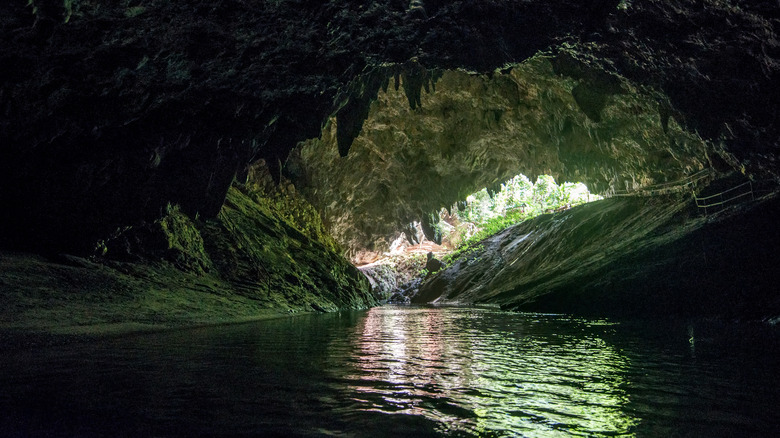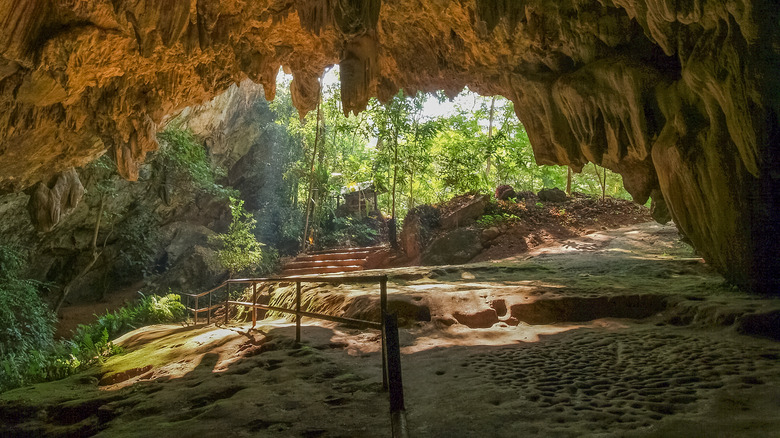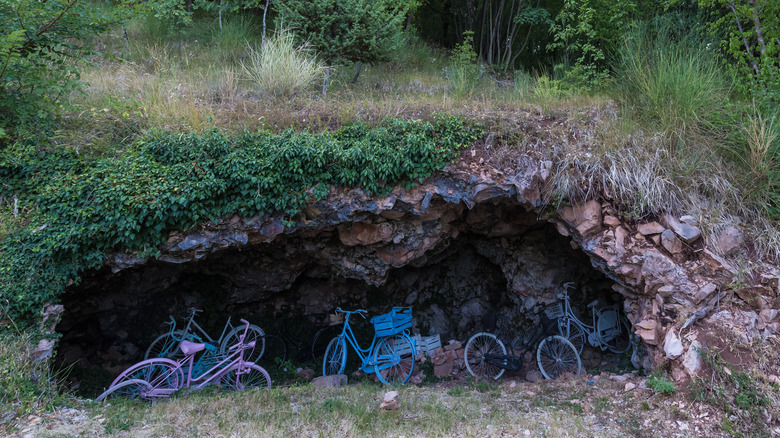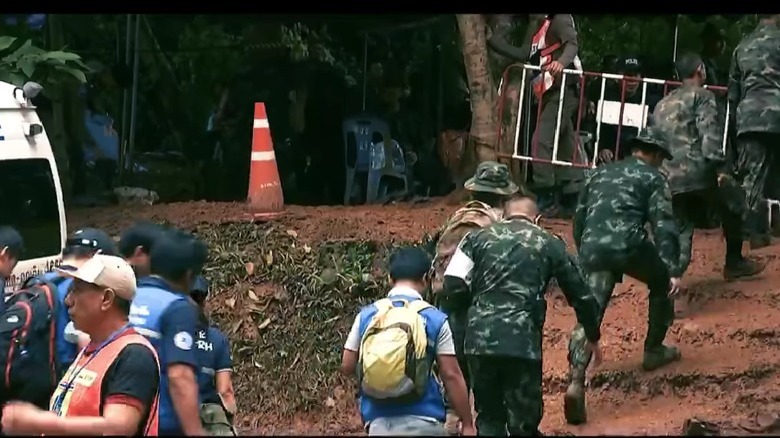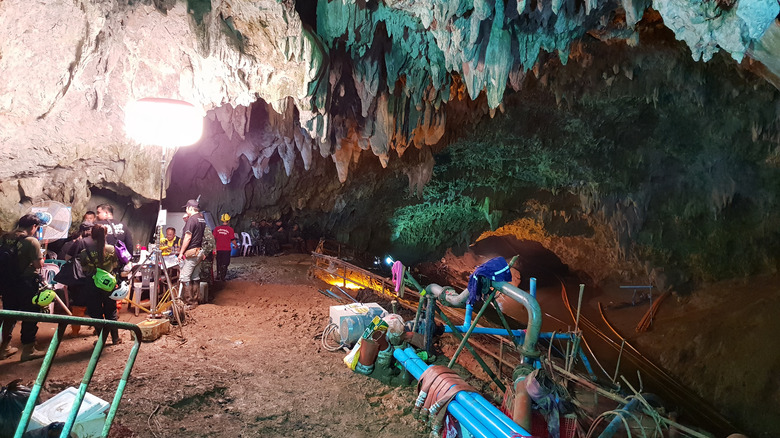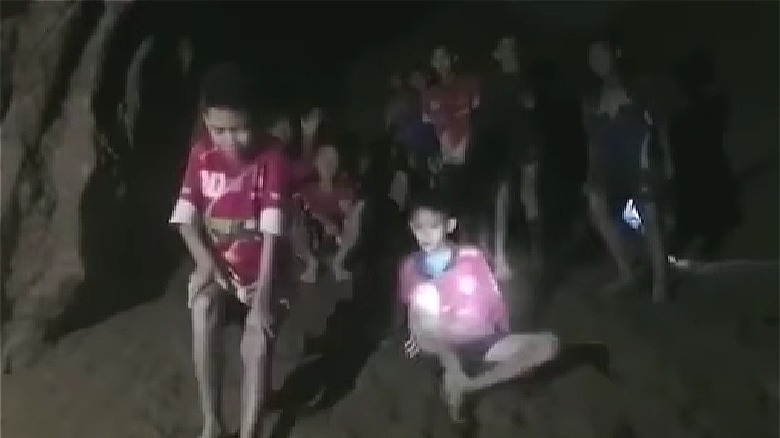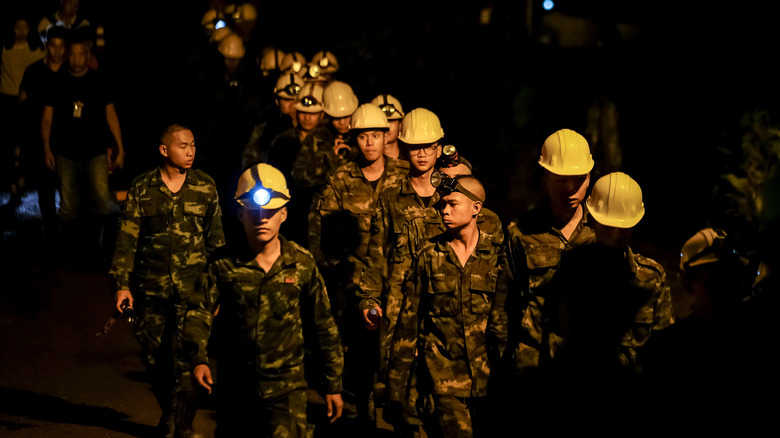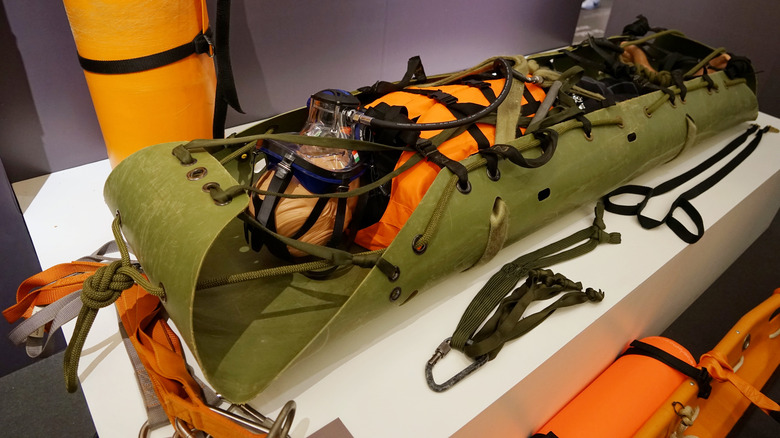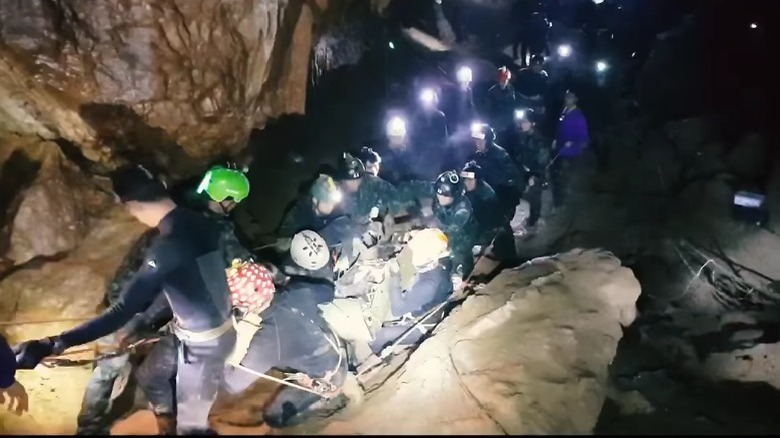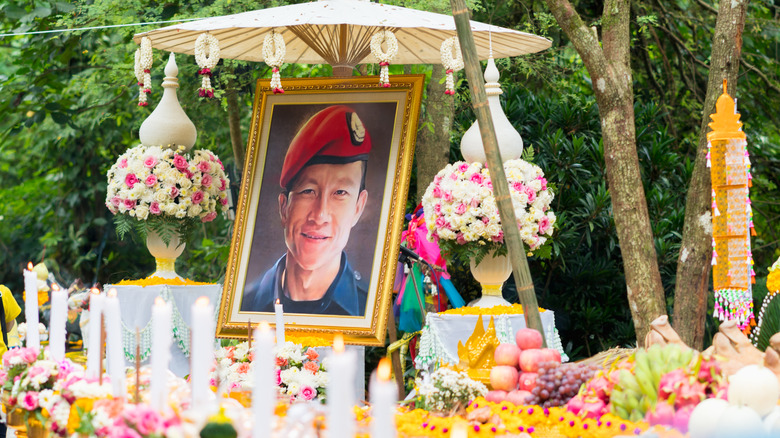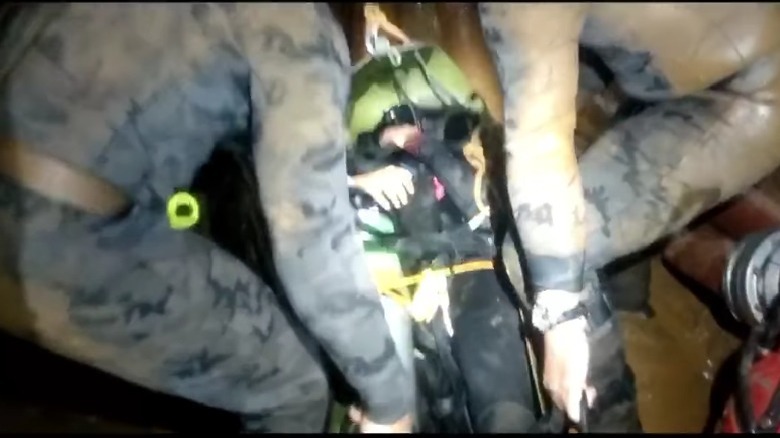The Real-Life Story Of The Tham Luang Cave Rescue
Fourteen-year-old Adul Samon faced harrowing experiences in the Tham Luang cave along with his 11 teammates and coach (via ABC News). The experience lasted for over a fortnight, attracting international attention. People from all over the globe tuned in for updates on the rescue efforts, and thousands of individuals volunteered to help. Samon and his peers faced seemingly insurmountable obstacles to survival, and yet he came away with impressive life lessons. He explains, "We learned about love by receiving love from everyone."
Since the successful rescue of the boys and 25-year-old Coach Ekkapol Chantawong (Coach Ek), their lives have been transformed. They recently enjoyed the ultimate frosting on the cake, having their lives immortalized in a new film, 2022's "Thirteen Lives," directed by Ron Howard and starring Colin Farrell, Viggo Mortensen, and Joel Edgerton. That's nothing to sneeze at, but then neither is their impossible rescue, which somehow managed to go off with only one major (and survivable) hitch.
Watching the movie trailer might make you assume Hollywood ratcheted up the drama with improbable plot lines and complications. But an examination of the real-life rescue shows just how razor-thin the margin for survival actually was. (One rescuer placed their odds at zero, according to National Geographic.) And yet all 13 made it out alive, with little more than minor scrapes and bruises. Here's what you need to know about the real-life story of the Tham Luang cave rescue, which outdoes any movie script (or cave system) with its many twists and turns.
The cave system was a regular haunt
An extremely complex and sophisticated rescue operation started out innocently enough, according to the BBC. The dozen teammates that called themselves the Wild Boars finished up their morning soccer practice in Chiang Rai province in northern Thailand before heading off for a quick excursion to one of their favorite places: the Tham Luang cave, History notes.
Weather in June in Thailand is usually humid and summery, with bouts of rain, as per Travelfish. Earlier rainfall dampened the earth; however, few other hints of the downpour soon to trap the boys and their assistant coach deep beneath the earth were to be found. The team had visited the cave countless times, making its various subterranean chambers their regular haunts. But while the Wild Boars and their coach scrambled through the lightless cave system, the skies above tore open, spilling unusually early monsoon rains on the area's verdant rice paddies and jungle-covered mountains (via History).
Within minutes, the cave entrance filled with turbid water, sending dangerous and drenching flows into the system of tunnels below. Before they realized what had happened, the 13 Wild Boars found themselves helplessly trapped beneath the jungle floor surrounded by swirling waters with no means of escape.
They were unprepared for an extended stay
Because the soccer team's forays into the cave system were so commonplace, they entered Tham Luang without gear or supplies, per ABC News. The cave system felt both familiar and spooky. Some teammates referred to it as "the hidden city," lauding its many chambers. Others called it "the underwater city," a more ominous pronouncement foreshadowing what Newsweek reports was an 18-day stay.
They only meant to spend an hour there, entering without extra clothing or food. But the so-called "hidden city" refused to release them for nearly a month. During their protracted stay, the boys and their coach benefited from drinkable water dripping from the perspiring cave walls, as reported by the BBC. As for breathable air, the cave system's various entrances permitted some oxygen (via Inverse). But it would drop dangerously low as the days progressed, per The New York Times.
Without backpacks, hiking snacks, or spelunking equipment, things looked grim for the amateur cave explorers. Fortunately, Coach Ekkapol Chantawong brought a rope, a flashlight, and spare batteries. At one point, he tried to find a way out: "I ... volunteered to dive to find out if I could go through or not. If I could go through then everybody is saved. So, we used the rope that we brought with us," he explained to the BBC. But after frantically searching beneath the water, Chantawong signaled for the boys to pull him back. Thus started an endless waiting game for the flood waters to recede.
An unattended birthday party sounded the red flag
The Wild Boars ranged in age from 11 to 16 (via the BBC), except for Peerapat "Night" Sompiangjai, who celebrated his 17th birthday on that fateful day, June 23, 2018, according to the BBC. At Sompiangjai's home, a colorful birthday party awaited, complete with a Spongebob Squarepants cake and ribbon-trimmed packages decked in shades of red, white, and blue. The whimsical collection of décor marked a fond farewell to childhood.
But as the hours ticked by with no signs of the young man or his pals, anticipation turned to alarm. As Smithsonian Magazine details, parents reached out to Nopparat Khanthavong, the Wild Boars' head coach, who tried to call Ekkapol Chanthawong. But Chantawong didn't answer. Next, Khanthavong called Songpol Kanthawong, a 13-year-old teammate picked up by his mother after practice. Kanthawong explained that his soccer mates had gone to the cave after practice.
Khanthavong raced to Tham Luang, finding telltale signs of the Wild Boars' presence near the entrance, including bikes, soccer shoes, and bags. A messaging app the boys used confirmed their location notes the BBC. People had gone missing in the Tham Luang cave system before, and locals knew it deserved respect. As the fourth largest Thai cave system, Tham Luang spiraled six miles beneath perpetually cloud-swathed mountains (via Smithsonian Magazine). During monsoon season, it transformed into a watery grave, deluged with up to 16 feet of water, as reported by the BBC.
Surviving a flooding cave
Those above ground couldn't see the struggle for survival the 13 faced below. As Coach Ekkapol Chanthawong recalls, "When we went in and got stuck in the cave, at that moment, we saw water. It's full of water," per ABC News. As flood waters overtook the cave, the Wild Boars and their coach descended 900 feet to escape the rapids and find dry ground in a chamber, according to Inverse.
They team ended up in the Pattaya Beach chamber, which sat 2.5 miles away from the entrance and offered the highest point of elevation the teammates could safely reach (via the BBC). There, they dug into the cave wall, using rocks to create a nook where they could huddle together to conserve body heat. Chanthawong rightly understood that the deepest challenges they faced would be mental and emotional.
Fortunately, he was a former Buddhist monk and accessed the teachings of this tradition to keep the teammates from panicking. By teaching them how to meditate, he made the harrowing experience endurable. He also provided them with positive thoughts while encouraging them to lie still to conserve energy and oxygen. Preventing the boys from panicking proved critical to their survival, as the oxygen within the cave remained a limited commodity, per the Associated Press (AP).
It took nine days before first rescuers reached them
The 13 occupants of the cave spent nine days in perpetual darkness without any way to tell how much time had passed, according to Smithsonian Magazine. Coach Ekkapol Chanthawong's makeshift meditation lessons helped buoy the boys' spirits, keeping them calm and optimistic despite biting cold, gnawing hunger, and the disorientation of sunless days and moonless nights. The meditation techniques kept hopelessness at bay, too, even as Chanthawong and the boys silently pondered whether they'd ever see their loved ones again (via ABC News).
What none of the teammates could imagine is that a massive international team of 10,000 individuals had assembled above-ground to save the boys, as per Smithsonian. This team included 200 divers, many of whom were cave diving experts. The floodwaters in the cave had not receded, and monsoon season proved perilously close. Coupled with dwindling oxygen levels, rescuers faced a race against time. Yet, nine days in they still had no clue where the Wild Boars were or whether they'd survived the initial downpour.
But then they got a break in the case thanks to two fearless cave divers, John Volanthen and Rick Stanton. The divers had already spent days swimming through the cave's intricate system of tunnels looking for signs of life when they finally experienced bittersweet success.
A mixture of hopeful and bleak revelations
On the ninth day of the 18-day operation, John Volanthen and Rick Stanton stumbled across the Wild Boars, as reported by Newsweek. One-and-a-half miles beneath the ground, they surfaced near a rocky shelf, and to their amazement, boys started appearing on the dry outcropping, as per Smithsonian Magazine. Volanthen later recounted calling out to them, "How many are you?" The reply of 13 relieved the divers while dropping a heavy weight on their shoulders. After all, they had yet to organize a bulletproof plan of action.
Adding to the weight they felt was the knowledge many of the tunnels within the subterranean labyrinth remained completely submerged. And the air pockets they sometimes ran into contained just 15.6% oxygen. (For context, Earth's atmosphere contains 21% oxygen, as reported by NASA.) Such low oxygen levels placed the Wild Boars at risk of hypoxia and its accompanying symptoms: restlessness, confusion, and headaches.
The lack of oxygen meant even the presence of rescue workers in the cavern could spell trouble for the boys and their coach. Coupled with the approach of monsoon season and more rainfall, the divers knew they faced the ultimate race against time. Adding to the complexity of the rescue effort was the teammates' physical weakness after nine days of limited water, scant food, and insufficient oxygen. None of them knew how to dive, and they didn't have time to learn. Things appeared simultaneously hopeful and bleak.
Masterminding a rescue plan that might work
Rick Stanton and John Volanthen knew better than anyone the rigors of cave diving, and Tham Luang even taxed their years of experience and training (via Smithsonian Magazine). Exiting the cave required hours underwater, squeezing through impossibly narrow crevices and passageways. What's more, the waters within the cave presented their own problems. From low visibility to strong and fast-moving currents, the Thai cave system was an obstacle course of hazards.
In one of the most powerful scenes from the movie "Thirteen Lives," Rick Stanton (played by Viggo Mortenson) spells out the likely outcome, "You try and dive those kids the whole way, all you'd be bringing out is dead bodies." In other words, the rescuers had to think outside of the box, and they had very little time to do so. Monsoon rains would arrive in force by mid-July. Fortunately, one of the rescue divers had a unique skill set capable of ensuring the survival of the 13, an Australian diver named Richard Harris.
In the movie, Harris is played by Joel Edgerton, and, as per BBC's Beyond Today, he is one of only three cave divers in the world with a career in anesthesiology. Yet, the potential savior of the children and their coach had no faith in the plan. The 13 Wild Boars were to be sedated and maneuvered out of the cave unconscious. In 2019, Harris confessed to National Geographic, "I put their odds of survival at zero."
A wild ride back to the surface
Despite overwhelming doubts, Richard Harris agreed to the plan, according to Smithsonian Magazine. But before proceeding, he was granted immunity from the Thai government. On July 8, 2018, the first round of rescues began with two boys. Harris administered Xanax and ketamine to render them calm and unconscious for the hours-long journey through Tham Luang's murky, foreboding waters. He also used atropine, a saliva-inhibitor, to keep the boys from choking, reports Newsweek.
Once sedated, rescue workers sealed the boys into oxygen masks and tied them to stretchers they could navigate through the cave's intricate tunnels (via Smithsonian). Two hours of the journey required total submersion (via WebMD). The rescuers had little to go on except the air bubbles coming from the boys' oxygen masks, indicating they still breathed.
Drier portions of the cave required other strategies, as reported by The New York Times. Rescue workers used the tops of hoses like a ramp to slide the boys down an especially steep area, and where the floors proved perilously craggy, they zip lined the boys over them on a 65-foot rope line. Floating stretchers also served the rescue effort, guided by Thai frogmen through one chamber. Five medical checkpoints ensured the kids remained peacefully unaware of their wild journeys. The unconventional rescue effort was also international, involving American search and rescue, Thai Navy SEALs, and British divers.
Overcoming one near-fatal hiccup
Unlike the rescuers who remained keenly aware of the complicated and intricate escape route the Wild Boars took to get back to the surface, the boys slept tranquilly in their makeshift cocoons (via The New York Times). Before waking up above-ground, their only previous memories were of sedation inside the cave.
From July 8-10, the boys' rescues proceeded, proving a success in all 12 cases, according to Newsweek. Coach Ekkapol Chanthawong came out last. During the rescue of the 11th boy, however, a heart-stopping mistake threatened tragedy. As the Times details, oOne of the divers lost hold of the rescue rope and couldn't find it in the opaque waters. Forced to swim deeper into the cave, the diver retraced his journey, finding the line once more.
Fortunately, number 11 got through with no further complications. Apart from this hiccup, the rescue effort moved along flawlessly, something that surprised every member of the effort. Maj. Gen. Chalongchai Chaiyakham stated, "The most important piece of the rescue was good luck. So many things could have gone wrong, but somehow we managed to get the boys out."
Two rescue divers died
While the 13 rescues proved successful, two divers involved in the Tham Luang effort died, as reported by the BBC. The first was a retired Navy SEAL named Saman Gunan who died on July 6 while delivering air tanks along one portion of the submerged rescue route, per The New York Times. Wichai Gunan, his father, swelled with pride when speaking of his son's sacrifice: "I'm very proud of him. He is a hero who did all he could to help the boys."
Although his family refused an autopsy, experts believe Gunan either died from hypothermia or asphyxiation. After all, the water in the cave proved so bone-chillingly cold, it made the divers' teeth chatter. And the steadily decreasing oxygen levels in Tham Luang's dry spots hung over the entire operation like a specter of doom throughout the two-week mission. A statue commemorating Gunan now stands at the entrance to the cave.
Tham Luang also posed invisible threats as one Thai Navy SEAL, Petty Officer Beirut Pakbara, found out firsthand. He contracted a deadly blood infection while lending a hand to the rescue effort. Over the next year and a half, his health deteriorated, and he died in December 2019, according to CNN.
Rescuers still can't believe it worked
To this day, those involved in the cave rescue have trouble believing their efforts worked, according to The New York Times. After all, swimming through the impossibly narrow crevices of the flooded Tham Luang cave system proved a challenge for the world's most experienced cave divers. They couldn't see their hands in front of their faces and dealt with strong currents, disorienting cold, and decreasing oxygen levels.
What's more, the cave had one final, powerful flourish in store for the rescuers. On day three of the rescue effort, all 13 Wild Boars had been rescued and a Navy SEAL team who stayed with the boys for eight days on the Pattaya Beach shelf had just exited the cave. Suddenly, one of the drainage pumps used to hold back flood waters failed.
The few remaining rescue workers in the cave had little more than a yelled warning and a few frantic minutes to scramble out of the cave before the chambers submerged beneath thick layers of muddy water. Chris Peterman, a scuba instructor and experienced cave diver, concludes, "Had the rescuers made any decisions other than the ones they did, the story would not have had such a successful outcome" (via Ars Technica).
Aftermath of the Tham Luang cave rescue
When the Wild Boars emerged from the Tham Luang cave system, they traded total isolation in pitch-black surroundings for the frenzy of an insatiable media storm (via Sports Illustrated). Psychiatric specialists consulted by Thai officials initially recommended a six-month hiatus before journalists could speak with the Wild Boars, with the exception of one interview granted to a Thai newscaster. The boys returned home, seeking the comforts of normalcy. Among the activities they picked up again were soccer practices with Coach Nopparat Khanthavong.
Within two months, their world changed drastically, however. Realizing the story of the boys in the cave could be cashed in, the Thai government reneged on its original plan, allowing ABC News to interview the boys and Coach Ekkapol Chanthawong. More than 800 outlets competed for the privilege, attesting to how sought-after the young men had become.
Dr. Rebecca Sheriff, a youth trauma expert, has expressed her concerns about the media circus facing the boys: "The main danger here, from the point that they got out of the cave, [has been] the media." The Wild Boars have since been on a whirlwind thank-you tour, appearing at Argentina's Youth Olympic Games, England's Old Trafford with Manchester United, and Japan's Fukushima Prefecture for a soccer match, among other stops. How emotional healing takes place under such circumstances remains to be seen. That said, no one can deny the Wild Boars' mental and physical fortitude under extreme conditions.

